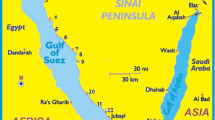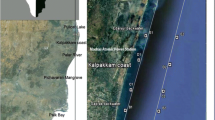Abstract
This work reports phytoplankton changes in a shallow, acidic and oligotrophic lake (Loch Rusky, Scotland) from two different periods: one with artificial phosphate fertilization and neutral pH (SRP 3–18 µg l-1, pH 6.6–7.8, 1972–73) and the other with low phosphate and acidic pH values (SRP <1.5 µg l-1, pH 5.6–6.9, 1985–86). Phosphate enhanced markedly total algal biomass and favoured the presence of cyanophytes, especially in the summer epilimnion, while cryptophytes dominated at this time during unfertilized periods. Anabaena sp. peaked during summer and a higher density of Ceratium hirundinella and Peridinium sp. in mid-summer was also observed during the fertilized period. Otherwise, algal composition and periodicity remained similar for the two comparative periods. In both, diatoms (Asterionella formosa and Aulacoseira italica) dominated during spring.
Similar content being viewed by others
References
Antonsson, U., 1992. The structure and function of zooplankton in Thingvallavatn, Iceland. Oikos 64: 188–221.
Arvola, L., 1980. Primary production and phytoplankton in two small, polyhumic forest lakes in southern Finland. Hydrobiologia 101: 105–110.
Bailey-Watts, A. E. & P. Duncan, 1981. The phytoplankton. In Maitland P.S. (ed), The largest lochs in Scotland. Dr. W. Junk Publishers, The Hague, 44: 91–118.
Brook, A. J., 1958. Changes in the phytoplankton of some Scottish hill lochs resulting from their artificial enrichment. Verh. int. Ver. Limnol. 13: 298–305.
Fott, J., M. Prazáková, E. Stuchlík & Z. Stuchlí ková, 1994. Acification of lakes in Sumava (Bohemia) and in the High Tatra Mountains (Slovakia). Hydrobiologia 274: 34–47.
Hörnström, E., C. Ekström, E. Fröberg & J. Ek, 1993. Plankton and chemical-physical development in six Swedish West Coast lakes under acidic and limed conditions. Can. J. Fish. aquat. Sci. 50: 688–702.
Ilmavirta, V., 1980. Phytoplankton in 35 Finnish brown-water lakes of different trophic status. Dev. Hydrobiol. 3: 121–130.
Jónasson, P. M., H. Adalsteinsson & G. Jónsson, 1992. Production and nutrient supply of phytoplankton in subarctic, dimictic Thingvallavatn, Iceland. Oikos 64: 162–187.
Leivestad, I., G. Hendrey, I. Muniz & K. E. Snekvi, 1976. Effects of acid precipitation on freshwater organisms. In Braekke F. (ed), Impact of acid precipition on forest and fresh-water ecosystems in Norway. S.N.S.F. project FR 6/76: 87–111, Oslo.
Maitland, P. S, B. D. Smith, G. M. Dennis, 1981. The crustazean zooplankton. In Maitland, P.S. (ed), The largest lochs in Scotland. Dr. W. Junk Publishers, The Hague: 135–154.
Maulood, B., 1974. Studies on the phytoplankton of Loch Lomond and of Neighbouring Lochs North and South of the Highland Boundary Fault. PhD Thesis, Glasgow University, 249 pp.
Moss, B., 1973. The influence of environmental factors on the distribution of freshwater algae: an experimental study. IV. Growth of test species in natural lake waters and conclusion. J. Ecol. 61: 193–211.
OECD, 1982. Eutrophication of waters. Monitoring, assessment and control, Paris, 154 pp.
Pugnetti, A., M. Manca, A. M. Nocentini, A. Boggero, R. Bettinetti, M. Bonardi & P. Cammarano, 1993. Ecological aspects of two alpine lakes (Lakes Paione, Italy). In Giussani, G. & C. Callieri (eds), Strategies for lake ecosystems beyond 2000. Stresa, Italy: 440–443.
Reynolds, C. S., 1992. Eutrophication and the management of planktonic algae: what Vollenweider could not tell us. In Sutcliffe, D. W. & J. G. Jones (eds), Eutrophication: research and application to water supply, Freshwat. Biol. Ass.: 4–29 pp.
Reynolds, C. S., G. H. M. Jaworski, J. V. Roscoe, D. P. Hewitt & D. G. George, 1998. Responses of the phytoplankton to a deliberate attempt to raise the trophic status of an acidic, oligotrophic mountain lake. Hydrobiologia 369370: 127–131.
Romo, S., 1987. The annual cycle of nutrients and phytoplankton dynamics in a shallow monomictic lake in Scotland (LochRusky). MSc. Thesis, Glasgow University, 133 pp.
Romo, S., 1990. Seasonal zooplankton patterns in a shallow oligotrophic lake: Loch Rusky (Scotland). Annls Limnol. 26: 11–17.
Sommer, U., Z. M. Gliwicz, W. Lampert, & A. Duncan, 1986. The PEG-model of seasonal succession of planktonic events in fresh waters. Arch. Hydrobiol. 106: 433–471.
Vyhnálek, V., J. Fott & J. Kopácek, 1994. Chlorophyll-phosphorus relationship in acified lakes of the High Tatra Mountains (Slovakia). Hydrobiologia 274: 171–177.
Watt Committee, 1984. Acid rain. Watt Committe on Energy, report n. 14. London, 55 pp.
Rights and permissions
About this article
Cite this article
Romo, S. Comparative study of phytoplankton in an oligotrophic soft water lake under different pH-phosphate ranges. Hydrobiologia 369, 133–137 (1998). https://doi.org/10.1023/A:1017078716841
Issue Date:
DOI: https://doi.org/10.1023/A:1017078716841




